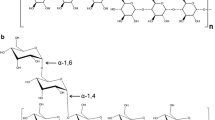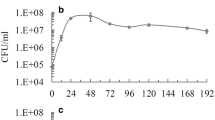Abstract
The use of natural antimicrobials from plants, animals and microorganisms to inhibit the growth of pathogenic and spoilage microorganisms is becoming more frequent. This parallels the increased consumer interest towards consumption of minimally processed food and ‘greener’ food and beverage additives. Among the natural antimicrobials of microbial origin, the killer toxin produced by the yeast Tetrapisispora phaffii, known as Kpkt, appears to be a promising natural antimicrobial agent. Kpkt is a glycoprotein with β-1,3-glucanase and killer activity, which induces ultrastructural modifications to the cell wall of yeast of the genera Kloeckera/Hanseniaspora and Zygosaccharomyces. Moreover, Kpkt maintains its killer activity in grape must for at least 14 days under winemaking conditions, thus suggesting its use against spoilage yeast in wine making and the sweet beverage industry. Here, the aim was to explore the possibility of high production of Kpkt for biotechnological exploitation. Molecular tools for heterologous production of Kpkt in Komagataella phaffii GS115 were developed, and two recombinant clones that produce up to 23 mg/L recombinant Kpkt (rKpkt) were obtained. Similar to native Kpkt, rKpkt has β-glucanase and killer activities. Moreover, it shows a wider spectrum of action with respect to native Kpkt. This includes effects on Dekkera bruxellensis, a spoilage yeast of interest not only in wine making, but also for the biofuel industry, thus widening the potential applications of this rKpkt.






Similar content being viewed by others
References
Ashida S, Shimazaki T, Kitano K, Hara S (1983) New killer toxin of Hansenula mrakii. Agric Biol Chem 47:2953–2955
Bai J, Swartz DJ, Protasevich II, Brouillette CG, Harrel PM, Hildebrandt E, Gasser B, Mattanovich D, Ward A, Chang G, Urbatsch IL (2011) A gene optimization strategy that enhances production of fully functional P-glycoprotein in Pichia pastoris. PLoS One 6(8):e22577. doi:10.1371/journal.pone.0022577
Bevan EA, Somers JM (1969) Somatic segregation of the killer (k) and neutral (n) cytoplasmic genetic determinants in yeast. Genet Res 14:71–77
Borneman AR, Zeppel R, Chambers PJ, Curtin CD (2014) Insights into the Dekkera bruxellensis genomic landscape: comparative genomics reveals variations in ploidy and nutrient utilisation potential amongst wine isolates. PLoS Genet 10(2):e1004161. doi:10.1371/journal.pgen.1004161
Burke DA, Dawson D, Stearns T (2000) Methods in yeast genetics: a Cold Spring Harbor Laboratory course manual. Cold Spring Harbor Laboratory Press, Plainview, NY
Bussey H, Skipper N (1975) Membrane-mediated killing of Saccharomyces cerevisiae by glycoproteins from Torulopsis glabrata. J Bacteriol 124:476–483
Butler AR, White JH, Stark M Jr (1991) Analysis of the response of Saccharomyces cerevisiae cells to Kluyveromyces lactis toxin. J Gen Microbiol 137:1749–1757
Cereghino GPL, Stark CM, Kim D, Chang J, Shaheen N, Poerwanto H, Agari K, Moua P, Low LK, Tran N, Huang HD, Nattestad M, Oshiro KT, Chang JW, Chavan A, Tsai JW, Cereghino JL (2013) The effect of α-mating factor secretion signal mutations on recombinant protein expression in Pichia pastoris. Gene 519:311–317
Cereghino JL, Cregg J (2000) Heterologous protein expression in the methylotrophic yeast Pichia pastoris. FEMS Microbiol Rev 24:45–66
Chang S-W, Lee G-C, Shaw J-F (2006) Codon optimization of Candida rugosa lip1 gene for improving expression in Pichia pastoris and biochemical characterization of the purified recombinant LIP1 lipase. J Agric Food Chem 54:815–822
Chen WB, Han YF, Jong SC, Chang SC (2000) Isolation, purification, and characterization of a killer protein from Schwanniomyces occidentalis. Appl Environ Microbiol 66:5348–5352
Ciani M, Fatichenti F (2001) Killer toxin of Kluyveromyces phaffii DBVPG 6076 as a biopreservative agent to control apiculate wine yeast. Appl Environ Microbiol 67:3058–3063
Ciani M, Comitini F (2011) Non-Saccharomyces wine yeasts have a promising role in biotechnological approaches to winemaking. Ann Microbiol 61:25–32
Comitini F, Ciani M (2009) The zymocidial activity of Tetrapisispora phaffii in the control of Hanseniaspora uvarum during the early stages of winemaking. Lett Appl Microbiol 50:50–56
Comitini F, Di Pietro N, Zacchi L, Mannazzu I, Ciani M (2004a) Kluyveromyces phaffii killer toxin active against wine spoilage yeasts: purification and characterization. Microbiology 150:2535–2541
Comitini F, De Ingeniis J, Pepe L, Mannazzu I, Ciani M (2004b) Pichia anomala and Kluyveromyces wickerhamii killer toxins as new tools against Dekkera/Brettanomyces spoilage yeasts. FEMS Microbiol Lett 238:235–240
Comitini F, Mannazzu I, Ciani M (2009) Tetrapisispora phaffii killer toxin is a highly specific β-glucanase that disrupts the integrity of the yeast cell wall. Microb Cell Factories 8(55). doi:10.1186/1475-2859-8-55
De Ingeniis J, Raffaelli N, Ciani M, Mannazzu I (2009) Pichia anomala DBVPG 3003 secretes a ubiquitin-like protein that has antimicrobial activity. Appl Environ Microbiol 75(4):1129–1134
De la Pena P, Barros F, Gascon S, Lazo PS, Ramos S (1981) The effect of yeast killer toxin on sensitive cells of Saccharomyces cerevisiae. J Biol Chem 256:10420–10425
Eisfeld K, Riffer F, Mentges J, Schmitt MJ (2000) Endocytotic uptake and retrograde transport of a virally encoded killer toxin in yeast. Mol Microbiol 37:926–940
Hatoum R, Labrie S, Fliss I (2012) Antimicrobial and probiotic properties of yeasts: from fundamental to novel applications. Front Microbiol 3(421). doi:10.3389/fmicb.2012.00421
Hodgson VJ, Button D, Walker GM (1995) Anti-Candida activity of a novel killer toxin from the yeast Williopsis mrakii. Microbiology 141:2003–2012
Hong F, Meinander NQ, Jönsson LJ (2002) Fermentation strategies for improved heterologous expression of laccase in Pichia pastoris. Biotechnol Bioeng 79:438–449
Kandel JS, Stern TA (1979) Killer phenomenon in pathogenic yeast. Antimicrob Agents Chemother 15:568–571
Kast A, Klassen R, Meinhardt F (2014) rRNA fragmentation induced by a yeast killer toxin. Mol Microbiol 91(3):606–617
Kimchi-Sarfaty C, JM O, Kim I-W, Sauna ZE, Calcagno AM, Ambudkar SV, Gottesman MM (2007) A ‘silent’ polymorphism in the MDR1 gene changes substrate specificity. Science 315:525–528
Klassen R, Paluszynski JP, Wemhoff S, Pfeiffer A, Fricke J, Meinhardt F (2008) The primary target of the killer toxin from Pichia acaciae is tRNAGln. Mol Microbiol 69(3):681–697
Laemmli UK (1970) Cleavage of structural proteins during the assembly of the head of bacteriophage T4. Nature 227(5259):680–685
Liu SQ, Tsao M (2009) Inhibition of spoilage yeasts in cheese by killer yeast Williopsis saturnus var. saturnus. Int J Food Microbiol 131(2–3):280–292
Lu J, Huang B, Esberg A, Johansson MJ, Byström AS (2005) The Kluyveromyces lactis gamma-toxin targets tRNA anticodons. RNA 11:1648–1654
Lowes KF, Shearman CA, Mackenzie D, Archer DB, Merry RJ, Gasson MJ (2000) Prevention of yeast spoilage in feed and food by the yeast mycocin HMK. Appl Environ Microbiol 66:1066–1076
Lucera A, Costa C, Conte A, Del Nobile MA (2012) Food applications of natural antimicrobial compounds. Front Microbiol 3(287). doi:10.3389/fmicb.2012.00287
Magliani W, Conti S, Gerloni M, Bertolotti D, Polonelli L (1997) Yeast killer systems. Clin Microbiol Rev 10:369–400
Macauley-Patrick S, Fazenda ML, McNeil B Harvey LM (2005) Heterologous protein production using the Pichia pastoris expression system. Yeast 22(4): 249–270.
Middelbeek EJ, Hermans JMH, Stumm C (1979) Production, purification and properties of a Pichia kluyveri killer toxin. A van Leeuw J Microb 45:437–450
Notario V (1982) β-glucanases from Candida albicans: purification, characterization and the nature of their attachment to cell wall components. J Gen Microbiol 128:747–759
Oro L, Zara S, Fancellu F, Mannazzu I, Budroni M, Ciano M, Comitini F (2014) TpBGL2 codes for a Tetrapisispora phaffii killer toxin active against wine spoilage yeasts. FEMS Yeast Res 14:464–471. doi:10.1111/1567-1364.12126
Palfree RG, Bussey H (1979) Yeast killer toxin: purification and characterization of the protein toxin from Saccharomyces cerevisiae. Eur J Biochem 93:487–493
Palpacelli V, Ciani M, Rosini G (1991) Activity of different ‘killer’ yeasts on strains of yeast species undesirable in the food industry. FEMS Microbiol Lett 68:75–78
Rosini G (1983) The occurrence of killer characters in yeasts. Can J Microbiol 29:1462–1464
Sambrook J, Fritsch EF, Maniatis T (1989) Molecular cloning: a laboratory manual. Laboratory Press, Cold Spring Harbor, NY
Schmitt MJ, Klavehn P, Wang J, Shoning I, Tipper DJ (1996) Cell cycle studies on the mode of action of yeast K28 killer toxin. Microbiology 142:2655–2662
Schifferdecker AJ, Dashko S, Ishchuk OP, Piškur J (2014) The wine and beer yeast Dekkera bruxellensis. Yeast 31:323–332
Sugisaki Y, Gunge N, Sakaguchi K, Yamasaky M, Tamura G (1984) Characterization of a novel killer toxin encoded by a double-stranded linear DNA plasmid of Kluyveromyces lactis. Eur J Biochem 141:241–245
Tiwari B, Valdramidis V, O’ Donnell CP, Muthukumarappan K, Cullen PJ, Bourke P (2009) Application of natural antimicrobials for food preservation. J Agric Food Chem 57(14):5987–6000. doi:10.1021/jf900668n
Todd BEN, Fleet GH, Henschke PA (2000) Promotion of autolysis through the interaction of killer and sensitive yeasts: potential application in sparkling wine production. Am J Enol Vitic 51:65–72
Ueda-Nishimura K, Mikata K (1999) A new yeast genus, Tetrapisispora gen. nov. Tetrapisispora iriomotensis sp. nov., Tetrapisispora nanseiensis sp. nov. and Tetrapisispora arboricola sp. nov., from the Nansei Islands, and reclassification Kluyveromyces phaffii (van der Walt) van der Walt as Tetrapisispora phaffii comb. nov. Int J Syst Bacteriol 49:1915–1924
Weiler F, Schmitt MJ (2003) Zygocin, a secreted antifungal toxin of the yeast Zygosaccharomyces bailii, and its effect on sensitive fungal cells. FEMS Yeast Res 3:69–76
Yamamoto T, Hiratani T, Hirata H, Imani M, Yamaguchi H (1986) Killer toxin from Hansenula mrakii selectively inhibits cell wall synthesis in a sensitive yeast. FEBS Lett 197:50–54
Yang Y-L, Chang S-H, Gong X, Wu J, Liu B (2012) Expression, purification and characterization of low-glycosylation influenza neuraminidase in α-1,6-mannosyltransferase defective Pichia pastoris. Mol Biol Rep 39:857–864
Yokomori Y, Akiyama H, Shimizu K (1988) Toxin of wild Candida killer yeast with a novel killer property. Agric Biol Chem 52:2797–2801
Young TW, Yagiu M (1978) A comparison of the killer character in different yeasts and its classification. Antonie Van Leeuwenhoek 44:59–77
Vandesompele J, De Preter K, Pattyn F, Poppe B, Van Roy N, De Paepe A, Speleman F (2002) Accurate normalisation of real-time quantitative RT-PCR data by geometric averaging of multiple internal control genes. Gen Biol 3:1–12
Zagorc T, Maraz A, Cadez N, Jemec KP, Peter G, Resnik M, Nemanic J, Raspor P (2001) Indigenous wine killer yeasts and their application as a starter culture in wine fermentation. Food Microbiol 18:441–451
Zhao H, Blazanovic K, Choi Y, Bailey-Kellogg C, Griswold KE (2014) Gene and protein sequence optimization for high level production of fully active and aglycosylated lysostaphin in Pichia pastoris. Appl Environ Microbiol 89(9):2746–2753
Acknowledgments
This study and S.L. were financially supported by Fondazione Banco di Sardegna with the project named ‘Produzione eterologa di una glicoproteina di lievito da impiegare come antimicrobico naturale nell’industria enologica e delle bevande’ (grant number 2014.0470 to IM). M.U. was financially supported by the ERASMUS Exchange Program between the University of Sassari and Istanbul Technical University.
Author information
Authors and Affiliations
Corresponding author
Ethics declarations
Funding
This study was funded by Fondazione Banco di Sardegna (grant number 2014.0470).
Conflict of interest
The authors declare that they have no conflict of interest.
Ethical approval
This article does not contain any studies with human participants or animals performed by any of the authors.
Rights and permissions
About this article
Cite this article
Chessa, R., Landolfo, S., Ciani, M. et al. Biotechnological exploitation of Tetrapisispora phaffii killer toxin: heterologous production in Komagataella phaffii (Pichia pastoris) . Appl Microbiol Biotechnol 101, 2931–2942 (2017). https://doi.org/10.1007/s00253-016-8050-2
Received:
Revised:
Accepted:
Published:
Issue Date:
DOI: https://doi.org/10.1007/s00253-016-8050-2




